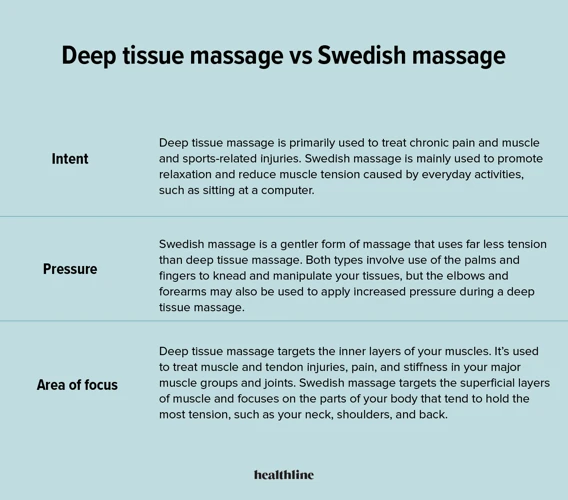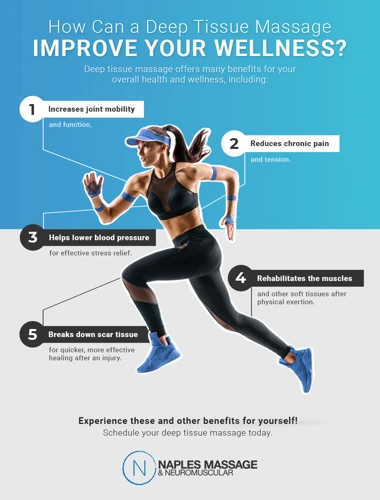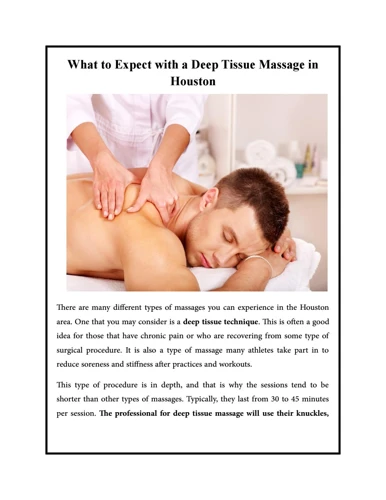Are you considering a deep tissue massage but aren’t sure what to expect? Knowing what to expect from a deep tissue massage can help you prepare and ensure that you get the most out of the experience. A deep tissue massage is a type of massage therapy that focuses on realigning deeper layers of muscles and connective tissue. It’s used to release chronic muscle tension and pain, and to treat issues such as injuries, inflammation, and stiffness. Pain may be felt during the massage, but the results are usually long-lasting relief. Read on to learn more about what to expect from a deep tissue massage.
Contents
Definition of Deep Tissue Massage

Deep tissue massage is a type of massage therapy that focuses on realigning deeper layers of muscles and connective tissue. It is especially helpful for chronically tense and contracted areas such as stiff necks, low back tightness, and sore shoulders. During a deep tissue massage, slow strokes and direct pressure are used to release tight muscles, break up scar tissue and increase circulation. The massage therapist may use knuckles, elbows, and even feet to increase the pressure and target deeper muscle layers. The goal of deep tissue massage is to break up scar tissue and release chronic muscle tension.
Benefits of Deep Tissue Massage

Improved Circulation
Deep tissue massage can help improve blood circulation in the body, allowing oxygen and nutrients to be more efficiently delivered to the muscles. This can lead to better performance, improved muscle recovery and less pain.
Reduced Muscle Tension
Deep tissue massage is effective in reducing muscle tension and restoring balance to the body. By applying pressure to specific areas of the body, the therapist is able to release tight muscles and improve flexibility.
Stress Relief
Deep tissue massage can help reduce stress and anxiety levels. The massage helps to relax the body and release endorphins, which are the body’s natural stress relievers. This can help improve overall wellbeing and mental clarity.
Types of Deep Tissue Massage

Swedish
Swedish massage is a type of massage that uses long strokes, kneading, deep circular movements, vibration, and tapping to help relax and energize you.
Trigger Point
Trigger point therapy, also known as myotherapy, is a type of massage therapy that focuses on releasing tight muscles, knots, and adhesions that form in the body due to injury or overuse.
Structural Integration
Structural Integration is a type of bodywork that focuses on the connective tissues in the body. It is designed to realign the body, improve posture, and restore balance. Structural Integration massage is often used to treat chronic pain, muscular tension, and postural misalignment.
Pain Associated with Deep Tissue Massage

Deep tissue massage is a type of massage therapy that focuses on the deeper layers of muscle and connective tissue. It is used to release chronic muscle tension and break up scar tissue that forms following injuries. During a deep tissue massage, the therapist will use firm pressure and slow strokes to reach the deeper layers of muscle and tissue. The massage may cause some discomfort during and after the session, but the benefits are well worth it.
Pressure
The pressure applied during a deep tissue massage is greater than that used in a traditional massage. The therapist will use their hands, elbows, and forearms to apply firm pressure to the muscle and tissue. Depending on the type of massage, the pressure applied may vary from light to deep.
Pain
The pressure applied during the massage may cause some discomfort, but it should not be unbearable. You may feel some soreness after the massage, but this is normal and should dissipate within a few days.
Benefits
Despite the potential for some discomfort during and after the massage, the benefits are well worth it. Deep tissue massage can help to reduce chronic pain and tension, improve range of motion, and reduce inflammation. It can also help to improve circulation, reduce stress, and improve overall wellbeing.
Preparing for a Deep Tissue Massage

- Wear Comfortable Clothing: Wear comfortable clothing that allows your massage therapist to access the areas that need to be massaged. Avoid wearing tight or restrictive clothing.
- Keep Hydrated: Drink plenty of water before and after your massage to ensure your body is hydrated and prepared for the massage.
- Communicate with Your Therapist: Tell your massage therapist about any health conditions, injuries, or areas of pain or discomfort. They will be able to adjust the massage accordingly to provide the most effective treatment.
- Take a Warm Shower: Taking a warm shower before your massage can help to loosen and relax your muscles and prepare your body for the massage.
- Arrive Early: Arrive at least 15 minutes before your massage appointment to give yourself time to relax and feel prepared for the treatment.
What to Expect During a Deep Tissue Massage
During a deep tissue massage, the massage therapist will use firm pressure and slow strokes to reach deeper layers of muscle and fascia. The massage is usually done on a massage table, with the patient lying on their stomach or back. The therapist might use their forearms, elbows, and knuckles to apply pressure and make sure the massage is deep enough.
Depending on the issue being treated, the massage therapist may focus on certain areas of the body. For example, if the patient is suffering from an injury, the therapist might focus on the areas surrounding the injury to release tension and reduce inflammation.
Patients may experience some discomfort during the massage, but it’s important to communicate with the therapist if the pressure is too intense. The massage therapist should be able to adjust the pressure accordingly.
The massage should leave the patient feeling relaxed and energized. After the massage, the patient may experience some stiffness or soreness, but this should go away within a few days.
Generally, deep tissue massage can provide relief from chronic pain, injury recovery, and improved range of motion. It can also reduce stress and tension in the body.
Aftercare

It is important to take it easy after a deep tissue massage. The body needs time to adjust to the changes that have been made. Drinking plenty of water is essential to help the body flush out any toxins that have been released during the massage. Stretching and light exercise can help to reduce soreness and stiffness. However, it is important to avoid strenuous activity for at least 24 hours, as this can cause further strain on the body. It is also advisable to use a hot or cold compress to help reduce any inflammation or soreness. If any discomfort or pain persists, it is important to speak to a doctor or massage therapist.
Cost
Deep tissue massage typically costs more than a standard massage due to the extra time and specialized techniques required to achieve the desired therapeutic effects. The cost of a deep tissue massage varies depending on the location and length of the treatment. Typically, a one-hour session can range from $50 to $200. Some massage therapists may offer discounted rates for longer sessions.
Frequently Asked Questions
Is a Deep Tissue Massage Safe?
- Safety: Deep tissue massage is generally considered safe when performed by a trained professional. It’s important to choose a therapist who is knowledgeable and experienced.
- Risks: The most common risk associated with deep tissue massage is soreness or minor muscle pain for a day or two following the session. Pain relief is usually felt within the first few days after the massage.
- Precautions: It’s important to tell the therapist about any health conditions or medications that may affect your massage. Also, if you are pregnant, it’s best to consult with your doctor before having a massage.
- Benefits: Deep tissue massage can help reduce muscle tension, improve circulation, and increase flexibility. It can also help relieve stress and alleviate pain.
How often should I get a deep tissue massage?
It depends on your individual needs. Generally, it’s recommended to get a deep tissue massage once or twice a month for maximum benefit. However, you may need to adjust this frequency depending on your condition and the severity of your pain.
- If you are dealing with chronic pain: you may want to get a deep tissue massage more frequently, such as once or twice a week.
- If you are using a deep tissue massage for relaxation: you may only need to get one every few weeks.
- If you have certain medical conditions: your doctor may recommend more or less frequent deep tissue massages.
It’s important to talk to your massage therapist about your individual needs and health conditions to determine the best frequency for your deep tissue massage.
Do I need to do anything to prepare for a Deep Tissue Massage?
To get the most out of your deep tissue massage, it’s important to be properly prepared. Before your massage, make sure to drink plenty of water and avoid eating a heavy meal. You should also take a warm shower or bath to loosen up your muscles. Additionally, it’s a good idea to wear loose, comfortable clothing so that your massage therapist can access the areas that need to be massaged.
What should I expect during a deep tissue massage?
- Pressure: During a deep tissue massage, the massage therapist will apply pressure and use various massage techniques to reach the deeper layers of muscle and fascia. The pressure should be comfortable, but it should be strong enough to penetrate the muscle tissue.
- Pain: Pain is almost unavoidable during a deep tissue massage. However, the massage therapist will adjust the pressure according to your pain threshold. If the pressure is too uncomfortable, tell the therapist immediately.
- Duration: A deep tissue massage usually lasts between 60 and 90 minutes.
- Location: The massage therapist will focus on specific areas of your body that require attention. This could include your back, neck, shoulders, arms, and legs.
- Movement: The massage therapist may use gentle stretching and movement to help increase circulation and release tension in the muscles.
- Communication: Open communication between you and the massage therapist is essential. Let the therapist know if the pressure is too intense or if you are in pain.
Are there any long-term benefits to getting a deep tissue massage?
Yes! Deep tissue massages can offer a variety of long-term benefits including:
- Reduced stress and anxiety
- Improved posture and flexibility
- Reduced chronic pain symptoms
- Improved sleep quality
- Improved blood circulation
Receiving regular deep tissue massages can help improve overall physical and mental wellness. It can also be used to supplement other treatments for a variety of medical conditions.
Conclusion
Deep tissue massage can provide relief from pain and tension, improve mobility and flexibility, and reduce stress. While the intensity of the massage can cause discomfort, most people find the massage to be deeply relaxing and beneficial for both physical and mental wellbeing. Ultimately, a deep tissue massage can be a great way to improve health and wellbeing.

